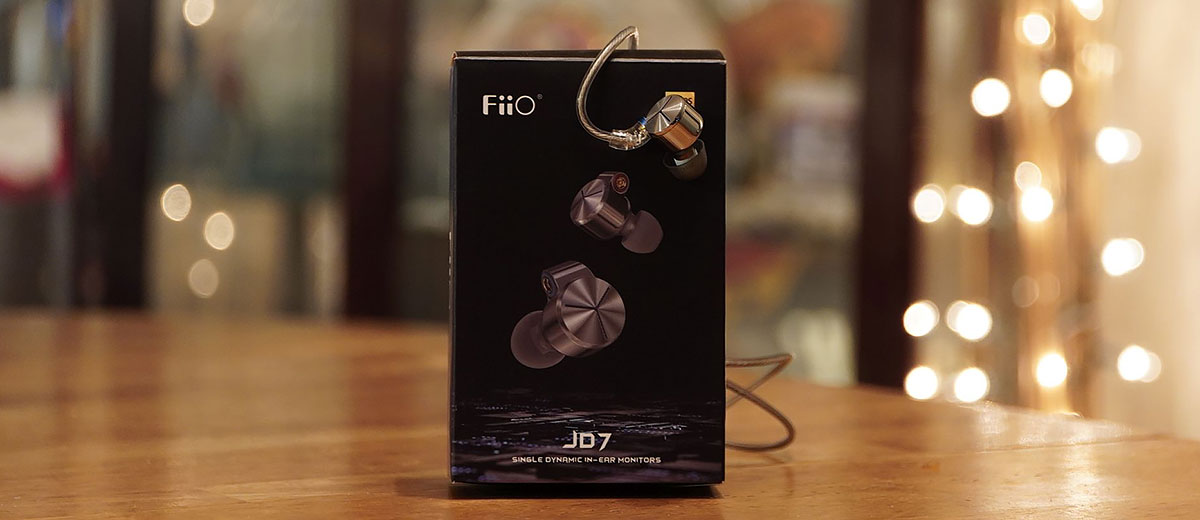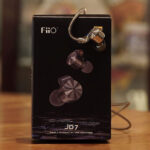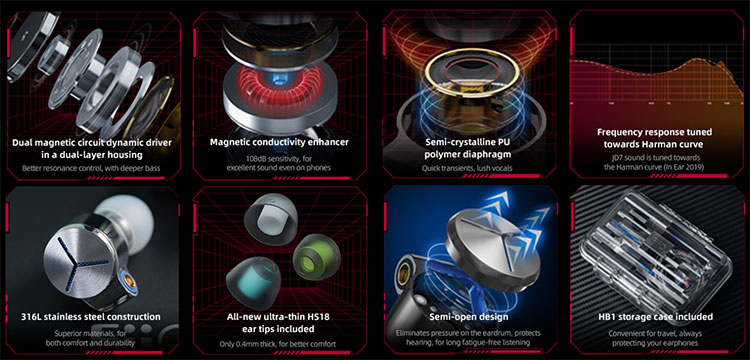Today, we review the FiiO JD7, which is a new entry-level single 10mm dual magnetic circuit dynamic driver semi-open in-ear monitor. It is currently priced from $79.99 with an SRP of $129.99
Disclaimer: This was sent to us as a sample for our honest opinion. Headfonics is an independent website with no affiliate links or services. We thank FiiO for its support.
You can click here to learn more about the FiiO gear we have previously highlighted on Headfonics.
Note, that this post follows our latest scoring guidelines which you can read here.
Today we review the FiiO JD7, which if you are a keen reader or fan of FiiO IEMs, then you might pick up its close resemblance to the FA7s which was reviewed back in 2021.
Starting from $79.99, it’s not priced anywhere near the FA7s which was retailing at $339.99 when first launched. Nor is it as complex for the internal driver configuration.
So, you can consider this as an entry-level or upper-budget tier IEM and one that is also developed in partnership with their sub-brand, Jade Audio.
Tech Highlights
The FiiO JD7 is a single 10mm dynamic driver IEM that claims to have both inner and outer magnetic pieces that are intended to help compensate for the magnetic flux density factor.
In doing so, they hope to achieve a more “effortless” appeal tone and texture. Further, the enclosure is a double-sealed dampening design, which effectively mutes resonance internally and offers as little distortion in the chambers as possible. They hoped to achieve a more resilient-sounding low-end (bass) experience with that design.
The result, in theory, would produce a transient appeal and be closer to an electrostatic tone than a typical dynamic driver sound type.
Another byproduct of this design is excellent efficiency, which comes from the great reduction of that magnetic density differential, as mentioned above. Effectively, this IEM is both very sensitive and very easily driven by a low-end cellphone. No amp is needed.
Design
The exterior shells are metal and etched with a unique design, shelled, and milled out of a solid chunk of stainless steel.
They are made of 316L stainless steel, which is an injection mold of purified powder that gets smashed and heated to over 1000 degrees. FiiO says they’ve opted for this design on construction to combat external wear and tear over years of usage.
These are semi-open, standard-style earbuds and do not leak very much sound despite that. Lately, there has been a slew of semi-open IEMs and sometimes it is great to block out the exterior world around me.
Sometimes, I forget what a totally closed and solid metal exterior does to the sound void that I am hearing and how that, in turn, distances me from the exterior surroundings around me. Sometimes, we reviewers go on a long trek with open headphones and forget, for a short time, what closed one’s can offer.
On the flip side, it is also great to have airiness and a sublimely open feeling audio experience as our lives get busier and busier, ever growing in the need to be spatially aware of life around us.
Comfort & Isolation
At just 8.6 grams, the JD7 is wonderfully comfortable in my ear. Despite being made of metal, one would think it is supremely heavy. But, the size of the IEM is not on the larger side, so the entire physical heft experience for the JD7 is just fine for me.
On the plus side, the new tips are very stable in my ear and the larger tip design helps keep the snug fit ongoing even when I am moving around. High marks on the comfort factor, at least in my opinion.
The metal heft factor can be felt on and, in my ear, and it is a bit annoying because of the over-the-ear hanging style. Annoying a tad, but not annoying a lot. It is not really bothersome, and I can still wear the JD7 for extended periods without any real discomfort.
Stock Cable
The FiiO JD7’s stock cable uses an MMCX-style connector termination. That which makes me happy because I have about 1000 other expensive cables that I can slap right on there without a problem.
Sure, the stock cable is nice, it is monocrystalline-silver that is copper plated and uses a standard 3.5mm connector on the headphone end. But what I also like is that the cable hardly moves when I move around.
The slack factor is lovely, and the exterior of the cable doesn’t glide over my shirt when I am walking around. It sort of just stays put due to the exterior material of the 3.9ft long cable itself.
Packaging & Accessories
Included in the package is a set of totally brand-new ear tip designs called the HS18. Apparently, they have a thickness factor of just 0.4mm and sadly I don’t have a way to accurately measure that, so I will totally trust them on that point.
They’ve also made sure to design the new tips to be a larger hole-bore design, which attempts to distance the ear canal from the inner areas of the ear tips.
This essentially produces a more coherent straight piped sound directly into the ear canal without any physical barriers or extra reflection potential ongoing. Also included is a standard clear FiiO carrying box. The stock product box is standard and tiny.
Sound Impressions
Bass
The JD7’s low end is semi-potent in low-end physical impact. Engaging and fun are the words I want to use. Annoying and painful is the opposite of the words I want to use, but it’s important to note that the physical amount of slam is on the higher side.
This is not a resolving and relaxed-sounding product; it is very plentiful but doesn’t cross the border towards being overblown.
More so, the bass feels like it hits in a pure way with very fast decay. This is what FiiO says they tried to design into the experience anyway, so I am not surprised to hear that. They wanted an effortless tunnel-like effect and that is what the IEM sounds like. It is very pure in tone, and very fast on hit and decay.
The JD7’s bass response can be altered to some degree with the usage of EQ and customizations in software. Or, if you have a bass switch on your amp, it would respond nicely to it but not as nice as some of the other middle-tier IEMs I’ve reviewed in the past that are on the $100ish level.
For example, the famous semi-electrostatic Shuoer Tape, effectively responds to EQ staggeringly well at that price point. Also, unlike the Stellaris from Moondrop, which has a tremendously negative response to anything bass-EQ related, the JD7 outperforms the Stellaris in that regard.
Mids
I feel the JD7 is a middle ground in terms of presentation in the mid-range; not too forward and not too relaxed.
Vocals are also very quick feeling, which makes the entire experience in Jazz tracks feel “effortless”, just as the company intended. But that comes at a cost, the cost of which is that overly slick appeal in tone loses engaging qualities in tone and heft.
The mids are very fast, yes that is true. But I do not find them engaging at all. And engagement in the vocal presentation areas of listening is vital to me.
I consider the midrange to be quite sterile and maybe even overly so. But that is not a bad thing for those looking for a sterile midrange. It is only a bad thing if you are specifically shopping for a very thick and meaty feeling vocal experience that is exaggerated.
Musicality vs accuracy. To each his own and this is not a downfall of the IEM, it’s just a preference thing. Which do you like more or want? If you want sterility, then the JD7 is a great pick.
Treble
The bite factor of the top end is very similar to the low end, it has the potential to snap pretty well at you if the track is very snappish.
The treble factor is bright yet doesn’t go into the annoyingly or painfully bright territory. We are riding the line of gentle zing factor, but this is a budget IEM so don’t expect the top side to be encased in marble and adorned with glistening perfect treble.
What is available is good, and thankfully not sibilant sounding or painful. Many budget IEMs can bite hard and go overly bright, but this is not so much the case.
FiiO has adopted a “let’s ride the border” with nearly every aspect of this product and I damned love it. They are teasing the beast, poking the tiger, basically. If you want it to go overboard, EQ it and you’ll get it.
If not, the problem there is that the treble seems to react to adding more, and very nicely so, but not so well to remove it. It is very stubborn with removal and drops 2-3dB from the highs resulting in a wonky sound.
So don’t touch the treble unless you want a bit more, then feel free to add 2dB if you so desire. The JD7 can handle that.
Imaging
The JD7’s imaging experience is very good for the price. Dare I say, for entry-level, it is one of the better open-feeling IEM’s out there due directly to its somewhat bright treble, and maybe even the new design of the ear tips that allow for more sound flow.
Perhaps both of those combined, along with the effortlessness and dynamic quickness of the driver, the perceived sound stage is larger than average in depth and width. It’s the height factor that feels out of place, smaller than the other two areas but still above average in what I consider its size.
Airiness is a strong suit of this product, and stage width separation is what I would consider the best feature of the IEM (outside of the lightning-fast response factor).
The IEM is on my list of extremely airy-feeling products in the budget tier, so I can recommend these often to those looking for a nice airy experience.
Synergy
No amps are needed at 32Ω. In fact, don’t put a balanced cable on it, that seems to overdrive the already somewhat potent low-end slam effect. Keep it unbalanced and enjoy it right off your phone or maybe your budget-tier DAP.
If you do want to run with an amp, let it be for tone change or taming. I use an Earmen TR-Amp, which really mellows down the top side and makes the low end feel fluffier and less sterile.
In that case, drop a totally different-sounding toned amp to tame the sterile tone of the JD7. You have options. You can make the headphone sound dimmed and a little woolier, less razor-like, depending on what amp or DAC you are using.
The JD7 pairs will go well with anything, so the synergy is very high. The IEM reacts nicely to different tone types in amps, but not by a lot. You can tame some portions of the experience enough for me to consider the IEM as nicely chameleon-like and that meshes with most, if not all amps out there.
Select Comparisons
FiiO FH1S
The JD7 is hyper-sterile in tone, the FH1S is far less sterile, but also less clean and clear. For $59, the FH1S seems very out of place now that the JD7 is here.
The imaging factor on the FH1S feels very closed in and one-dimensional, vs the very open and more dynamically interesting JD7. Also, the build is much better on the JD7 with its fully metal design vs the FH1S’s acrylic design features.
TRN Kirin
The TRN Kirin is a Planar and the JD7 is a standard dynamic driver. Both sell for roughly $100 or less right now. The Kirin feels heaps heftier than the JD7 on the low end, but it also is much slower.
The JD7’s tone is highly sterile and smaller in staging compared to the Kirin. I didn’t get as nice a fit with the Kirin as I did with the JD7. The Kirin also comes with a plethora of extra accessories including a 4.4mm balanced option cable, but the JD7 doesn’t come with any other extras like that.
Overall, the Kirin lacks the spaciousness of the JD7 in imaging but it also has more of a realistic density factor in vocals that makes the midrange feel more realistic than the JD7.
Moondrop Stellaris
Two totally different-sounding IEMs for basically the same price. The Stellaris is Planar in design, so it feels hefty and thicker in tone presentation, the JD7 is razor-sharp, thinner, and more sterile.
Stellaris is also huge by comparison and fits less nicely in my ear but also feels like a dense magnetron of a black hole in my hand (it’s very heavy). The JD7 is much lighter, despite still being fully metal in design.
The bass on the Stellaris is more physical sub 50Hz, however, the JD7 reaches extends better but is less physical. The JD7 is very fast on bass and the Stellaris is slow as nails.
Our Verdict
The FiiO JD7 is another budget overlord for the audio community. This is a great little IEM. If you like a more analytical approach to the tone, this is a great pick for you.
You also don’t need any amplification but if you have it, toss it in there anyway and see what the result tone taming can do for you if you want it. The JD7 responds very well to different gears. It is lightning-fast and does certainly feel more effortless than most other average-tier IEM’s out there.
FiiO JD7 Technical Specifications
- Drivers: 10mm Dynamic
- Impedance: 32Ω
- Frequency Response: 20Hz – 40kHz
- Sensitivity: 108dB/mW@1kHz
- Cable: 1.2m
- Connector: 3.5mm / MMCX











